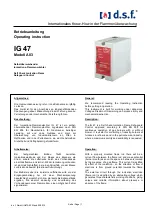
Auxiliary T1 DTE Interface (Drop-and-Insert)
Some Access-T models include an auxiliary port for a T1 DTE. (Table 2-B
identifies the models having an auxiliary T1 DTE interface.) Unused DS0s in the
T1 DTE signal can be dropped, and signals from the other DTE ports can be
inserted in their place (hence the term “drop-and-insert”). Figure 2-4 shows how
the drop-and-insert function works.
The auxiliary T1 DTE interface supports any equipment providing a D4- or
ESF-framed T1 signal with data channellized in DS0s.
Note:
The auxiliary port does not support a hardwired
loopback or a back-to-back connection with another Access-T
auxiliary port.
The auxiliary T1 DTE port can be configured for the following parameters:
•
Format:
D4 or ESF.
•
Line coding:
AMI or B8ZS.
•
Equalization (Distance from DTE to Access-T):
Up to 655 feet.
•
Pulse stuffing:
Forcing bit 7 always to be a ONE (toward the network
only).
•
Alarm Indication Signal:
Generation of AIS to the line (or Aux port)
when LOS or LOF occurs at the auxiliary port (or line). At least one
DS0 must be assigned to the aux port for AIS to be generated.
•
Yellow transcoding:
Whether Yellow Signal is transcoded from a D4
auxiliary port to an ESF line or vice versa. At least one DS0 must be
assigned to the aux port for AIS to be generated.
The auxiliary port physical interface is as follows:
Access-T 1-Port, 2-Port, and 4-Port units employ a female DA15 con-
nector. An adapter is available to convert to an RJ48 jack.
Access-T 1500 units employ two 50-pin male RJ48H connectors.
Larscom offers an accessory kit that consists of two standard 50-pin
female AMP CHAMP connectors. You must connect the leads for
each Aux connection to support your cabling configuration. Refer to
Chapter 3 and Appendix E for more information on Aux port connec-
tors and accessory kits.
ACST-0351-005
Chapter 2
June 1996
Access-T Functional Overview
2-13
















































